



Which of the following graphs corresponds to the inequality x > 7?
Please select A, B, C or D.
A.  |
B.  |
C.  |
D.  |
A.
Incorrect. The arrow pointing to the right indicates x is less than 7 rather than x > 7.
B.
Correct! The open circle at 7 and the arrow pointing to the right indicate x > 7.
C.
Incorrect. The closed circle and arrow pointing to the left indicate x is less than or equal to 7 rather than x > 7.
D.
Incorrect. The closed circle indicates x is greater than or equal to 7 rather than x > 7.
Which of the following graphs corresponds to the inequality x < 4?
Please select A, B, C or D.
A.  |
B.  |
C.  |
D.  |
A.
Incorrect. The open circle indicates x < 4 rather than x is less than or equal to 4.
B.
Incorrect. The open circle at 4 and arrow pointing to the right indicate x > 4 rather than x is less than or equal to 4.
C.
Correct! The closed circle at 4 and arrow pointing to the left indicate x is less than or equal to 4.
D.
Incorrect. The arrow pointing to the right indicates x is greater than or equal to 4 rather than x is less than or equal to 4.
Which of the following graphs corresponds to the inequality y > – 2 3 x + 1?
Please select A, B, C or D.
A.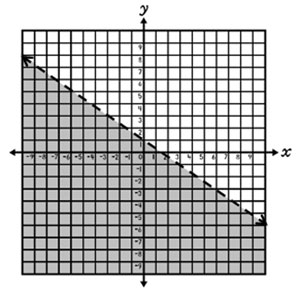 |
B.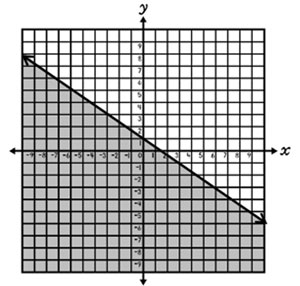 |
C. 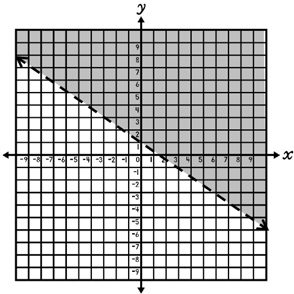 |
D.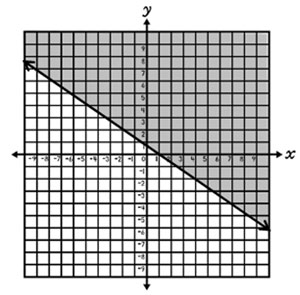 |
A.
Incorrect. The dashed line and shading below the line indicate y < 2 3 x + 1 rather than y < - 2 3 x + 1.
B.
Incorrect. The dashed line and shading below the line indicate y ≤ - 2 3 x + 1 rather than y > - 2 3 x + 1.
C.
Correct! The dashed line and shading above the line indicate y > - 2 3 x + 1.
D.
Incorrect. The dashed line and shading below the line indicate y ≥ - 2 3 x + 1 rather than y > - 2 3 x + 1.
Which of the following graphs corresponds to the inequality y ≤ - 1 2 x − 4?
Please select A, B, C or D.
A.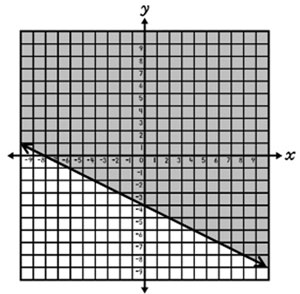 |
B.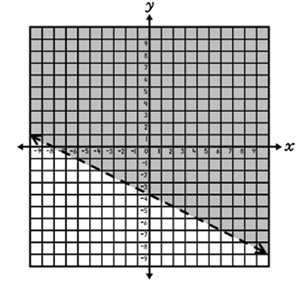 |
C. 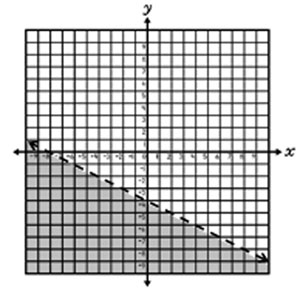 |
D.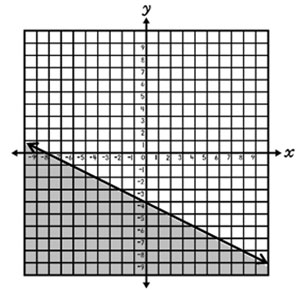 |
A.
Incorrect.
The solid line and shading above the line indicate y ≥ - 1 2 x ≥ 4 rather than y ≤ - 1 2 x − 4.
B.
Incorrect. The dashed line and shading above the line indicate y > - 1 2x − 4 rather than y < − 4.
C.
Incorrect. The dashed line and shading below the line indicate y < − 4 rather than y ≤ − 4.
D. Correct! The solid line and shading below the line indicate y ≤ − 4.
Which of the following graphs corresponds to the inequality y < x?
Please select A, B, C or D.
A.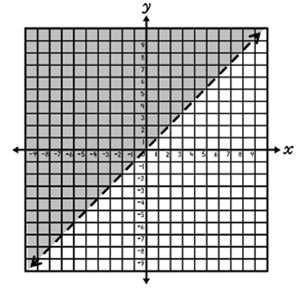 |
B.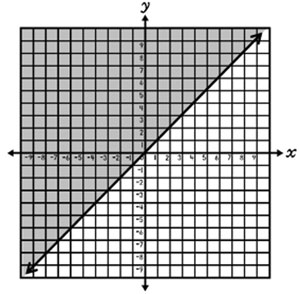 |
C. 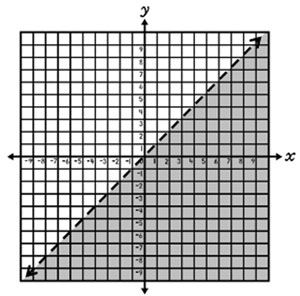 |
D.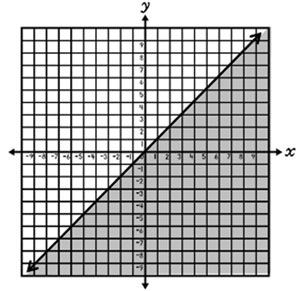 |
A.
Incorrect. The dashed line and shading above the line indicate y > x rather than y < x.
B.
Incorrect. The solid line and shading above the line indicate y is greater than or equal to x rather than y < x.
C.
Correct! The dashed line and shading below the line indicate y < x.
D.
Incorrect. The solid line and shading below the line indicate y is less than or equal to x rather than y < x.
Which of the following graphs corresponds to the inequality 3x − 5y ≤ 10?
Please select A, B, C or D.
A.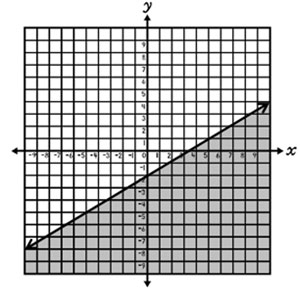 |
B.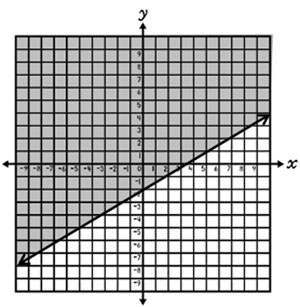 |
C. 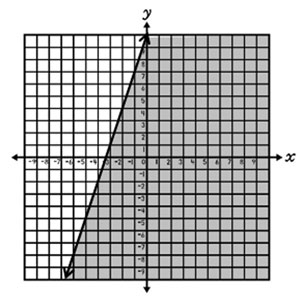 |
D.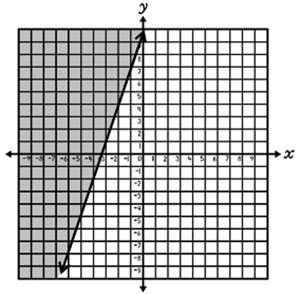 |
A.
Incorrect. The shading below the line indicates 3x − 5y is greater than or equal to 10 rather than 3x − 5y is less than or equal to 10.
B. Correct! The solid line and shading above the line indicate 3x − 5y is ≤ to 10 or y ≥ 3 5x − 2.
C.
Incorrect. The inequality 3x − 5y is less than or equal to 10 can be written in the form y is greater than or equal to 3 5x − 2. Therefore, the graph should have a y-intercept of -2 and a slope of 3 5.
D. Incorrect. The inequality 3x − 5y is ≤ to 10 can be written in the form y is ≥ 3 5x − 2. Therefore, the graph should have a y-intercept of -2 and a slope of 3 5.
Which of the following graphs corresponds to the inequality 2x + 3y > 6?
Please select A, B, C or D.
A.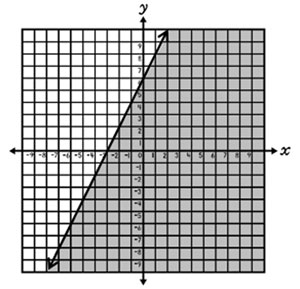 |
B.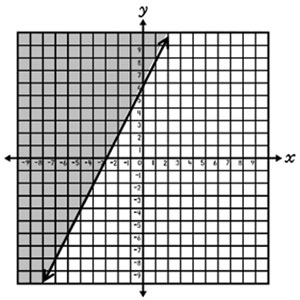 |
C. 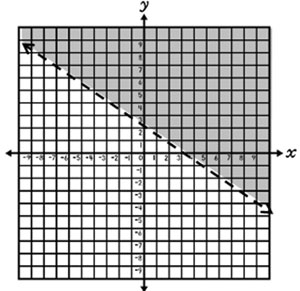 |
D.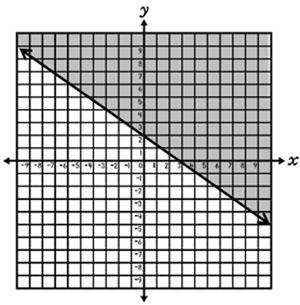 |
A.
Incorrect. The inequality 2x + 3y > 6 can be written in the form y > - 2 3x + 2. Therefore, the graph should have a y-intercept of 2 and a slope of - 2 3.
B. Incorrect. The inequality 2x + 3y > 6 can be written in the form y > - 2 3x + 2. Therefore, the graph should have a y-intercept of 2 and a slope of - 2 3.
C. Correct! The dashed line and shading above indicate 2x + 3y > 6 or y > - 2 3x + 2.
Incorrect. The solid line indicates y is ≥ - 2 3x + 2 rather than y > - 2 3x + 2.